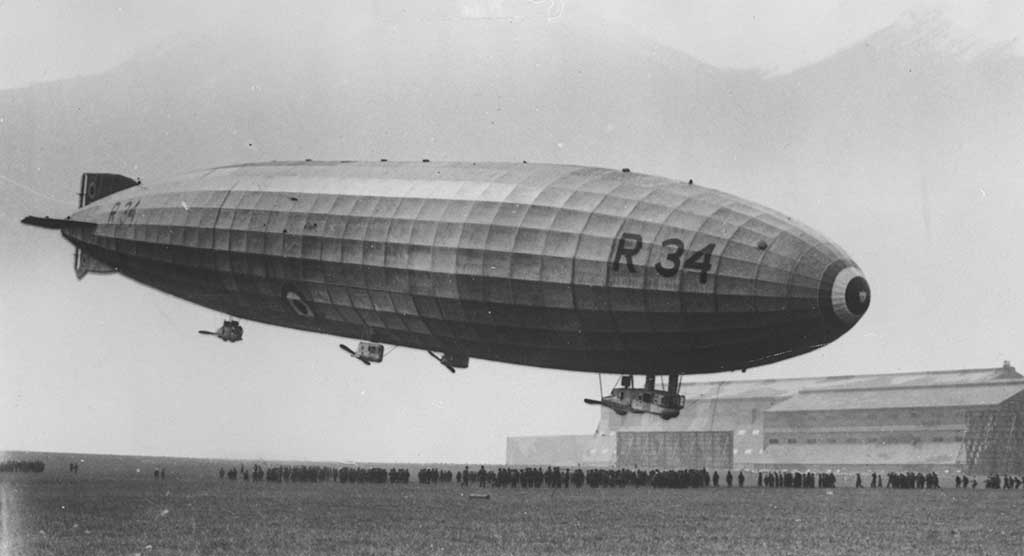
Search is on for descendants of R.34 airship’s crew
The National Museum of Flight will this weekend start to celebrate the centenary year of one of its East Fortune home’s most famous aerial adventures.
It will commemorate the record-breaking 6,000-mile double-Atlantic crossing of the giant R.34 airship.
The Museum is hoping that visitors will use the anniversary as a reason to visit and learn about the epic journey, which was the first ever return flight across the Atlantic and the first east-west crossing by air.
The voyage began on 2 July 1919, just a few weeks after Alcock and Brown’s record-breaking west-east Atlantic flight. The R.34’s trip also involved the first arrival in the USA by air when Major Pritchard parachuted from the airship to instruct the ground crew, as well as the world’s first human and feline trans-Atlantic aerial stowaways, Newcastle man, William Ballantyne and Wopsie the cat.
The 634ft R.34, nick-named Tiny, was stationed at East Fortune, now home to the National Museum of Flight but which started out as a Royal Naval Air Station.
The airships came under the command of the Navy as their primary duties were convoy protection and anti-submarine activities. HMA R.34 arrived at East Fortune in May 1919.
She had been constructed at the Wm Beardmore factory at Inchinnan near Glasgow but was completed too late to see active service. She had one operational voyage over the Baltic Sea as part of a show of strength in advance of the ratification of the Treaty of Versailles.
Her main claim to fame came in July 1919 when she and her crew of 30 set off on the first direct flight between Britain and the USA. The initial destination was Mineola in Long Island, USA, where rolling grasslands and favourable winds made it a popular choice for aviators including the Wright Brothers.
The R.34 reached Mineola at 9.45am on 6 July 1919, 108 hours and 12 minutes after it departed East Fortune, following an adventure-filled journey that was hampered by dwindling fuel supplies, violent squalls and a leak that was repaired with the crew’s entire supply of chewing gum.

The R.34 airship at East Fortune
The story of the R.34’s record-breaking journey is told as part of the National Museum of Flight’s Fortunes of War permanent display, which brings to life the fascinating history of the Museum’s East Fortune home. It features objects such as the large bowplate from the R.34, the airship’s altimeter dial, binoculars and a camera used on the flight as well as a bottle of brandy taken on board for medicinal reasons.
The exhibition also includes a piece of the linen fabric from the airship’s outer cover, part of one of the internal gas-bags and a piece of girder from the airship. Visitors can also see a memorial to the flight, a twin of which exists in Mineola. Elsewhere at the Museum, an R.34 flight simulator lets families recreate the flying experience of the record-breaking giant.
Ian Brown, assistant curator of aviation at the National Museum of Flight, said: ‘The story of the R.34 is packed with insights into the technologies and social history of the time. It was a huge undertaking that was front-page news both in the UK and the USA and it’s fascinating to know that the crew really were convinced that large, rigid airships like the R.34 were the future of long-distance travel.
‘We’re very proud that our East Fortune home has such close links to this historic adventure and hope that as many people as possible will visit during this centenary year to learn more about it.’
To mark the centenary, the National Museum of Flight is also launching a search for images of memorabilia plus recollections from descendants of the R.34’s crew members which it hopes to develop into a digital gallery to help tell the airship’s story. The crew was the toast of the town on arrival in the USA and was welcomed by President Woodrow Wilson at New York Town Hall. The R.34 then flew over the sky scrapers of New York as it set off for home.
Ian continued: ‘Brigadier-General Maitland’s log book of the journey gives a fascinating description of the trip and the reception the crew received but we know that each crew member will have had his own story to tell about the voyage.
‘We’d love to hear from their descendants with any recollections that may have been passed down the generations and would be delighted if they could send us pictures of any R.34 memorabilia that is still in the family.’
Anyone wishing to share stories or images for the National Museum of Flight’s R.34 Digital Gallery should email info@nms.ac.uk, call 0131 247 4238 or post to National Museum of Flight, East Fortune Airfield, East Lothian, EH39 5LF.
The National Museum of Flight, including the Fortunes of War permanent display, is open seven days a week from 10am until 5pm (30 March – 31 October).
Visit www.nms.ac.uk/flight for details and further information.
TAGS

